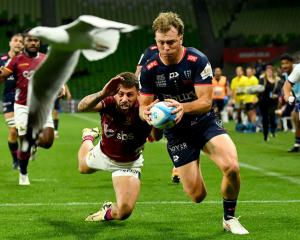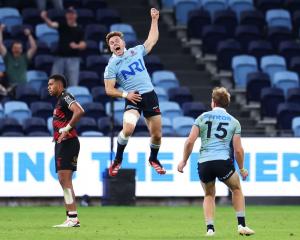
Poor from All Blacks, not good from Scotland
The closeness of this game was not due to the brilliance of Scotland.
Rather it was the ineptitude of the All Blacks which kept it so close for so long. Other than the try they were gifted through an intercept,
Scotland did not look like scoring. Never did they have the All Blacks under pressure on defence.
Their backs did not offer much, making the occasional line break, but hardly forcing the New Zealanders to scramble to any great extent. In close they were tough and organized, as always.
It was here where they stifled the All Blacks attack which was too predictable and prevented them from unleashing their backs.
From the All Blacks there was not enough impact and too many errors. The result was a poor game in which some very, very average rugby was played by both teams.
Too predictable on attack
The Scots seemed to have the All Blacks attack worked out pretty well and were stifling it before they ever really got going.
In fact, most teams are doing a better job of doing this these days. In general, they use forward runners as targets in close, often having two or three and sometimes looking to deliver a short ball from the initial ball carrier.
From there, they can get the opposition going backwards and then look to attack through the midfield and down the wings. But it requires that they get some go-forward to start with. In this game that never came.
Teams are switching onto the All Blacks patterns now and are fanning out to stop the initial momentum. Without any strong runners in close, the All Blacks struggled to get go-forward and the Scots were lining up the ball runners and knocking them over before they got going.
There were then too many instances where the ball runner got isolated for a second. They generally recovered from this, but it gave Scotland a chance to slow down the All Blacks ruck ball, which in turn allowed their defence to regroup.
Scotland is good at this. The key to beating them is to get the ball wider, as they tend to get lost with players running in space, while also changing the direction of the attack, as they often lack awareness on defence.
Perhaps it could be an option to utilize the pick and go a bit more too. At least this would force the defence to stay a bit narrower and should open up some more gaps out wider. Ultimately it is not such a problem when the likes of Brodie Retallick, Owen Franks and Jerome Kaino are playing, but they will want to be mindful that they do not become too easy to read.
Catch and pass under pressure
As a follow-up from the last point, the short ball from the first forward runner to the second is something they have persisted with, but it is something that still does not look a good option. It is a pass and a reception under pressure, while also often it results in the ball carrier becoming isolated, as the defence usually takes the passer, who is the first support player, as well as the ball carrier.
While it has worked on occasion, there are too many other times where it has resulted in a turnover. It is a pass and catch under pressure, pressure which is unnecessary to put yourself under.
Important to have experienced heads
The best quality of the All Blacks of recent years has been their ability to get the job done.
No matter how poorly, or how well, they might play, they seem to find a way to win. That has come from having a core group of guys who have been there for a long time now and know what needs to be done.
This week the All Blacks had a lot of youth on the field. In the closing stages there were very few regulars from the past four or five years on the field.
Their experience was huge, with the game very much in the balance. It allowed the team to keep their composure and work themselves into a position where they could strike.
From this we saw the influence of Richie McCaw, even when he is having a below average game. It would have been a lot less comfortable in those final ten minutes without him on the park. The same could be said, to a lesser extent, about Liam Messam and perhaps even Julian Savea and Ben Smith.
Is Dominic Bird really the next best lock?
The majority of the selections over the past three years have been good ones. One which remains questionable is that of Dominic Bird.
Other than a huge frame, it is hard to see what he brings to the table at the international level.
Even a Super Rugby level he has hardly excelled. He is not ruthless physically, or athletic in the open and while he gets through some work, it is no more than what most locks would get through.
Come next year it will likely be Sam Whitelock, Brodie Retallick, Jeremy Thrush and Luke Romano whom will get the nod anyway. But even in the short term, players such as Tom Franklin, James Broadhurst and Joe Wheeler look to offer more with their high work rates and proven track records.
The All Blacks have not been too bad with it in recent years, but it is important to pick players based on how good they are on the field, not how big they are.












